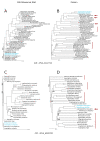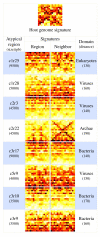Whole genome evaluation of horizontal transfers in the pathogenic fungus Aspergillus fumigatus
- PMID: 20226043
- PMCID: PMC2848249
- DOI: 10.1186/1471-2164-11-171
Whole genome evaluation of horizontal transfers in the pathogenic fungus Aspergillus fumigatus
Abstract
Background: Numerous cases of horizontal transfers (HTs) have been described for eukaryote genomes, but in contrast to prokaryote genomes, no whole genome evaluation of HTs has been carried out. This is mainly due to a lack of parametric methods specially designed to take the intrinsic heterogeneity of eukaryote genomes into account. We applied a simple and tested method based on local variations of genomic signatures to analyze the genome of the pathogenic fungus Aspergillus fumigatus.
Results: We detected 189 atypical regions containing 214 genes, accounting for about 1 Mb of DNA sequences. However, the fraction of atypical DNA detected was smaller than the average amount detected in the same conditions in prokaryote genomes (3.1% vs 5.6%). It appeared that about one third of these regions contained no annotated genes, a proportion far greater than in prokaryote genomes. When analyzing the origin of these HTs by comparing their signatures to a home made database of species signatures, 3 groups of donor species emerged: bacteria (40%), fungi (25%), and viruses (22%). It is to be noticed that though inter-domain exchanges are confirmed, we only put in evidence very few exchanges between eukaryotic kingdoms.
Conclusions: In conclusion, we demonstrated that HTs are not negligible in eukaryote genomes, bearing in mind that in our stringent conditions this amount is a floor value, though of a lesser extent than in prokaryote genomes. The biological mechanisms underlying those transfers remain to be elucidated as well as the biological functions of the transferred genes.
Figures





Similar articles
-
Detection and characterization of horizontal transfers in prokaryotes using genomic signature.Nucleic Acids Res. 2005 Jan 13;33(1):e6. doi: 10.1093/nar/gni004. Nucleic Acids Res. 2005. PMID: 15653627 Free PMC article.
-
Horizontal transfer and evolution of prokaryote transposable elements in eukaryotes.Genome Biol Evol. 2013;5(5):822-32. doi: 10.1093/gbe/evt057. Genome Biol Evol. 2013. PMID: 23563966 Free PMC article.
-
HGT-Finder: A New Tool for Horizontal Gene Transfer Finding and Application to Aspergillus genomes.Toxins (Basel). 2015 Oct 9;7(10):4035-53. doi: 10.3390/toxins7104035. Toxins (Basel). 2015. PMID: 26473921 Free PMC article.
-
Genomics of the fungal kingdom: insights into eukaryotic biology.Genome Res. 2005 Dec;15(12):1620-31. doi: 10.1101/gr.3767105. Genome Res. 2005. PMID: 16339359 Review.
-
Fungal genomics: a tool to explore central metabolism of Aspergillus fumigatus and its role in virulence.Adv Genet. 2007;57:263-83. doi: 10.1016/S0065-2660(06)57007-5. Adv Genet. 2007. PMID: 17352907 Review.
Cited by
-
The function and evolution of the Aspergillus genome.Trends Microbiol. 2013 Jan;21(1):14-22. doi: 10.1016/j.tim.2012.09.005. Epub 2012 Oct 17. Trends Microbiol. 2013. PMID: 23084572 Free PMC article. Review.
-
MTGIpick allows robust identification of genomic islands from a single genome.Brief Bioinform. 2018 May 1;19(3):361-373. doi: 10.1093/bib/bbw118. Brief Bioinform. 2018. PMID: 28025178 Free PMC article.
-
Globally distributed root endophyte Phialocephala subalpina links pathogenic and saprophytic lifestyles.BMC Genomics. 2016 Dec 9;17(1):1015. doi: 10.1186/s12864-016-3369-8. BMC Genomics. 2016. PMID: 27938347 Free PMC article.
-
Horizontal Gene Transfer Involving Chloroplasts.Int J Mol Sci. 2021 Apr 25;22(9):4484. doi: 10.3390/ijms22094484. Int J Mol Sci. 2021. PMID: 33923118 Free PMC article. Review.
-
Horizontal gene transfer in plants.Funct Integr Genomics. 2014 Mar;14(1):23-9. doi: 10.1007/s10142-013-0345-0. Epub 2013 Oct 17. Funct Integr Genomics. 2014. PMID: 24132513 Review.
References
Publication types
MeSH terms
Substances
LinkOut - more resources
Full Text Sources
Miscellaneous

